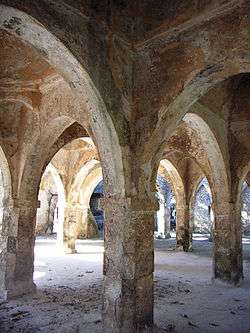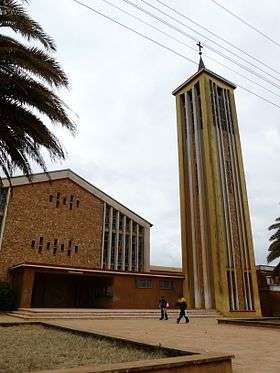Religion in Tanzania
| Part of a series on the |
| Culture of Tanzania |
|---|
 |
| History |
| People |
| Languages |
| Religion |
|
Music and performing arts |
| Sport |
|
Monuments |
|
Symbols |
|
Current statistics on religion in Tanzania are unavailable because religious surveys have been eliminated from government census reports since 1967. Religious leaders and sociologists estimate that Muslim and Christian communities are approximately equal in size, each accounting for 30 to 40 percent of the population, with the remainder consisting of practitioners of other world faiths, practitioners of indigenous religions, and people of no religion.[2]
Statistics


For many years estimates have been repeated that about a third of the population each follows Islam, Christianity and traditional religions.[3]
As there is obviously no more such a large percentage of traditional religionists [4] a range of competing estimates has been published giving one side or the other a large share or trying to show equal shares. A 2010 Pew survey found 61.4 percent of respondents to be Christian, 35.2 percent to be Muslim, 1.8 percent to follow traditional African religions, 1.4 percent to be unaffiliated, and 0.1 percent to be Hindu.[5] Religion-related statistics for Tanzania have been regarded as notoriously biased and unreliable.[6]
About 98 percent of the population in Zanzibar is Muslim.[7] There are also active communities of other religious groups, primarily on the mainland, such as Buddhists, Hindus, Sikhs, and Bahá'ís.[7] A 2015 study estimates some 180,000 Christian believers from a Muslim background in the country, most of whom are Protestants of some form.[8]
Abrahamic
Christianity
The Christian population is largely composed of Roman Catholics and Protestants. Among the latter, the large number of Lutherans and Moravians point to the German past of the country while the number of Anglicans point to the British history of Tanganyika. All of them have had some influence in varying degrees from the Walokole movement (East African Revival), which has also been fertile ground for the spread of charismatic and Pentecostal groups.
Islam
On the mainland, Muslim communities are concentrated in coastal areas, with some large Muslim majorities also in inland urban areas especially and along the former caravan routes. The majority of the country's Muslim population is Sunni of Shafi school of jurisprudence; the remainder consists of several Shia subgroups (20%), mostly of Asian descent and the Ahmadiyya Islamic movement (15%).[9][2]
Bahá'í Faith
Indian religions

Buddhism
Hinduism
Religion and society

The Constitution provides for freedom of religion, and the Government generally respects this right in practice. There have been cases of increased tension between secular and fundamentalist Muslims as the latter have called for Muslims to adopt a stricter interpretation of Islam in their daily lives.[2]
Notable places of worship
- Azania Front Lutheran Church – Lutheran
- Christ Church, Zanzibar – Anglican
- Gaddafi Mosque – Islamic
- Great Mosque of Kilwa – Islamic (Historical)
- Ijumaa Mosque – Islamic
- Kizimkazi Mosque – Islamic
- St. Joseph's Cathedral, Dar es Salaam – Catholic
See also
References
- ↑ "Africa :: TANZANIA". CIA The World Factbook.
- 1 2 3 International Religious Freedom Report 2007: Tanzania. United States Bureau of Democracy, Human Rights and Labor (September 14, 2007). This article incorporates text from this source, which is in the public domain.
- ↑ So repeated here: (USA government), Central Intelligence Agency. "The World Fact Book". Retrieved 25 May 2014.
- ↑ note continued adherence to traditional beliefs also among Christians and Muslims:"(In Tanzania) more than half the people surveyed believe that sacrifices to ancestors or spirits can protect them from harm." see Pew report Christians and Muslims in Subsaharan Africa (2010)
- ↑ "Global Religious Diversity", Pew Forum on Religion and Public Life, 2014, page 22, accessed 17 October 2014
- ↑ Abdulaziz Y. Lodhi and David Westerlund. "African Islam in Tanzania". Retrieved 25 May 2014.
- 1 2 "International Religious Freedom Report for 2013" (PDF). United States Department of State. Retrieved 17 October 2014.
- ↑ Johnstone, Patrick; Miller, Duane (2015). "Believers in Christ from a Muslim Background: A Global Census". IJRR. 11: 14. Retrieved 20 November 2015.
- ↑ "The World's Muslims: Unity and Diversity" (PDF). Pew Forum on Religious & Public life. August 9, 2012. Retrieved June 2, 2014.
